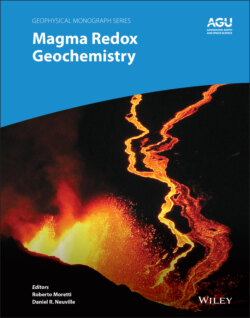Читать книгу Magma Redox Geochemistry - Группа авторов - Страница 31
2.3.3. Temporal and Spatial Evolution of the Redox State of the Asthenospheric Mantle
ОглавлениеThe oxygen fugacity of the ambient mantle, source of MORBs, and the deep convecting mantle sporadically sampled by plumes and kimberlitic melts both control the speciation of volatiles and hence the locus of the peridotite solidus and the nature of the melts that are produced (Wyllie & Huang, 1975; Canil & Scarfe, 1990; Green, 2015). In addition, mantle fO2 plays a role in mantle rheology and therefore dynamics, whereby more oxidizing conditions enhance concentrations and mobilities of lattice defects, resulting in a viscosity reduction (Cline et al., 2018). Given its importance, great efforts have been made to constrain mantle redox evolution, which is necessary to accurately capture mantle geodynamics and melting behaviour. For example, redox melting, whereby upwelling mantle will intersect the equilibrium C(graphite/diamond) + 2Fe2O3(melt) = 4FeO + CO2 (both in the melt) due to increasing fO2 with decreasing pressure, will occur in the depth interval of ~150 to 120 km at modern mantle redox conditions (Stagno et al., 2013), where MORB records fO2 of ~0.4±0.4 log units below the buffer (Frost & McCammon, 2008; Stagno, 2019). This process explains the production of kimberlites and some carbonatites, the rarity of which in the Archean has been ascribed to more reducing mantle conditions by 0.5 to 0.7 log units (Foley, 2011). Indeed, using the V/Sc redox proxy, a well‐characterized mantle eclogite suite from Lace in the Kaapvaal craton, with demonstrated spreading ridge‐derived origin, has yielded an fO2 (FMQ) of –1.7±1.1 for the ambient mantle at ca. 3 Ga (Aulbach & Viljoen, 2015). Based on this value, redox melting occurs at substantially shallower depths (~100 to 80 km; Aulbach & Stagno, 2016) with the formation of carbonate–silicate magmas, precluding the formation of carbonatite below typically thicker continental lithosphere, and possibly restricting the formation of kimberlites to unusually oxidized and/or warm mantle regions. Using additional mantle and orogenic eclogite suites sampling Proterozoic to Archean spreading ridges, the ambient mantle was shown to have evolved across the Archean–Proterozoic boundary, from ∆logƒO2 of ~FMQ‐1.19±0.33 to FMQ‐0.26±0.44 (Aulbach & Stagno, 2016). This evolution is exactly mirrored by that recorded in komatiites, which show an increase in ~1.3 log units between 3.48 and 1.87 Ga (Nicklas et al., 2018, 2019; Fig. 2.3a). This increase and the absolute fO2 values recorded across the Archean–Proterozoic are well within the range of, and therefore not in conflict with, proposed values after magma ocean solidification (~FMQ‐3 to FMQ) obtained from thermodynamic and climate modelling (Pahlevan et al., 2019). On the other hand, the compositions of inclusions in sublithospheric diamonds testify to the strong chemical and redox gradients, ranging from carbonates to solidified iron–nickel–carbon–sulfur melts (Brenker et al., 2007; Kaminsky et al., 2015; Smith et al., 2016). Indeed, diamond formation is favoured by contrasting redox states, which are typically achieved when deeply subducted slabs containing oxidized components are juxtaposed with the predominantly reducing, metal‐saturated mantle at depths > 250–300 km (Foley, 2011; Rohrbach & Schmidt, 2011). Thus, we take the relatively high fO2 retrieved from the ferric iron content of majorite inclusions in sublithospheric diamonds (Kiseeva et al., 2018) to indicate local mantle conditions in the vicinity of recycled slabs that are not representative of the mantle as a whole.
